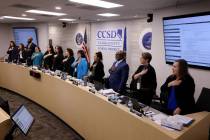High court may revisit affirmative action
Economist Walter Williams -- who is black -- famously cites the harm done to young African-American students by recruiters for top-notch colleges who bend their schools' standards to get them admitted. As a result, black students who might have fared fine at a mid-level college drop out of the high-pressure, elite colleges at a high rate, unnecessarily convincing them they're failures.
Many thought affirmative action was a settled issue after the Supreme Court handed down a pair of decisions in June 2003, narrowly approving the consideration of race in admission decisions at the University of Michigan -- though that tentative approval came with lots of restrictions and a sort of expiration date.
In Gratz v. Bollinger, the court ruled 6-3 that the university's undergraduate admissions policy was unconstitutionally discriminatory because it automatically awarded a bonus to applicants who were underrepresented minorities. But in Grutter v. Bollinger, the court upheld the law school's policy of considering race as part of a "holistic" evaluation of an applicant. Writing for the majority, Justice Sandra Day O'Connor said at the time government had a compelling interest in diversity, including seeking a "critical mass" of minority students.
"We expect that 25 years from now, the use of racial preferences will no longer be necessary to further the interest approved today," Justice O'Connor added.
But it's been a lot less than 25 years, but guess what? Affirmative action is back. Two recent lower court decisions make it likely that the high court will take up the issue again soon.
One is from Texas, where a panel of the 5th U.S. Circuit Court of Appeals upheld a race-conscious admissions policy at the University of Texas. An attempt to have the entire circuit hear the case failed 9-7, with dissenters practically inviting the Supreme Court to step in. The other case is again from Michigan, where voters in 2006 passed a constitutional amendment to forbid the state's public colleges and universities from granting "preferential treatment to any individual or group on the basis of race, sex, color, ethnicity, or national origin."
A panel of the 6th U.S. Circuit Court of Appeals ruled 2-1 that the amendment violates the equal protection clause of the 14th Amendment "because it restructures the state's political structure to the detriment of minorities," The Washington Post reports.
Huh? As Michigan Attorney General Bill Schuette so concisely put it, while warning his next stop could be the Supreme Court: "It's absurd to conclude that banning racial discrimination somehow perpetuates racial discrimination."
It may all have started with good intentions -- proponents insisted it was merely about "reaching out," letting minority applicants know they're welcome. But in the hands of number-crunching bureaucrats, affirmative action inevitably transposed into minority quotas and set-asides.
We don't need quotas to force the hiring of more whites to play for the National Basketball Association, or more blacks in the National Hockey League, to use one of Mr. Williams' examples of the absurdity of such an approach. Nor, in a competitive world economy, can America afford to turn away talented future scientists and engineers because a college already has "too many Asians," while places have been arbitrarily set aside for lower-scoring candidates of other races.
That's not the American way. Equal opportunity means just that -- not racial quotas, but everyone given an equal chance, under the same standards, regardless of what they look like.
Here's hoping the high court finally sees it that way, too.























